|
Experimental Proofs of Gene Character and Transmission of the Extreme Dilute Color in
Syrian Hamsters
The approach to learning about this gene required several steps. First was demonstrating that the phenotype was genetic in origin and not some random oddity occurring in one individual.
Second was understanding its mode of transmission, and third was associating it with other known genes. 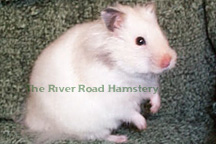 Initially, there was just the one smoke-white female so the process was begun with her. As the other animals became available, it was suspected that they might represent an effect of the
same phenomenon on different colors, and they were utilized to broaden understanding in this direction and to support breeding data from the original females's lineage. Initially, there was just the one smoke-white female so the process was begun with her. As the other animals became available, it was suspected that they might represent an effect of the
same phenomenon on different colors, and they were utilized to broaden understanding in this direction and to support breeding data from the original females's lineage.
Proof of Genetic Basis
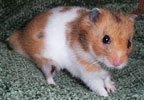 She was bred to an unrelated Golden male. The litter consisted of five Goldens and two BECs. Some were
Banded. The color looked completely normal for type. One of the Golden sons (shown here) was saved for backcrossing. In the backcross litter of 12 there were three normal Goldens
and one normal Cinnamon. The remaining eight consisted of: She was bred to an unrelated Golden male. The litter consisted of five Goldens and two BECs. Some were
Banded. The color looked completely normal for type. One of the Golden sons (shown here) was saved for backcrossing. In the backcross litter of 12 there were three normal Goldens
and one normal Cinnamon. The remaining eight consisted of:
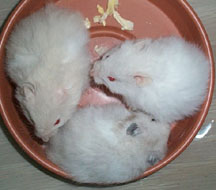 Three pale agouti greys much like the mother. These had grey ears (mottled from Banding), grey
cheekflashes and black eyes with a red glint in certain light. At birth their eyes appearred dark red. The fur was uniformly very pale grey to the roots except for darker grey
tipping. Three pale agouti greys much like the mother. These had grey ears (mottled from Banding), grey
cheekflashes and black eyes with a red glint in certain light. At birth their eyes appearred dark red. The fur was uniformly very pale grey to the roots except for darker grey
tipping.- Three overly pale nonagouti creams with red eyes. The hair was the same color to the roots.
- Two whites that looked FEW except that there was a suggestion of a creamy tint around the nose.
This preliminary breeding indicated that the trait was genetic in nature and not just that the original female had bizarre coloring from some nongenetic cause. It also suggested that it was
transmitted recessively, although it would have been possible for a dominant gene to be absent from the first litter just by chance.
Proof of Recessive Transmission
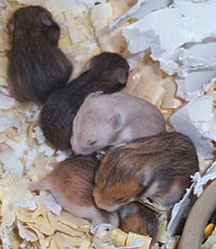 From the first litter above (all normally colored) several hamsters were kept, and two definitive crosses
were made. A BEC daughter was mated to a Golden son producing a litter of seven -- five Golden and two matching the original female. A Golden daughter was mated to an unrelated Umbrous
Golden male known to carry DEW. The litter of seven consisted of three Umbrous Golden, two Golden, one Sable, and one with the original female's phenotype. Five pups from this litter are
pictured to the right. From the first litter above (all normally colored) several hamsters were kept, and two definitive crosses
were made. A BEC daughter was mated to a Golden son producing a litter of seven -- five Golden and two matching the original female. A Golden daughter was mated to an unrelated Umbrous
Golden male known to carry DEW. The litter of seven consisted of three Umbrous Golden, two Golden, one Sable, and one with the original female's phenotype. Five pups from this litter are
pictured to the right.
The additional importance of this second litter was that it suggested that the gene was a C locus allele, combining with cd from the sire to give the new phenotype.
Crosses to Support the C Locus Possibility
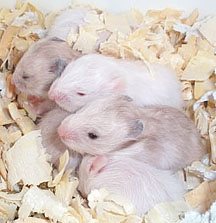 If the gene were a C locus allele, then breeding one of the affected hamsters to a Dark Eared White should
produce nothing but the parental types, either Dark Eared White or dilute phenotypes. Nine crosses of this type were done yielding 73 pups, divided almost equally between white and either the
very pale agouti grey of the original female or other diluted color types. This photo shows greys, whites and a pale cream (bottom) from one of the litters. No full-color hamsters came from any
of these matings. As homozygous hamsters were developed at a later date, 3 crosses were done between these and a Dark Eared White. Twenty-seven pups all had heterozygous dilute
phenotypes. If the gene were a C locus allele, then breeding one of the affected hamsters to a Dark Eared White should
produce nothing but the parental types, either Dark Eared White or dilute phenotypes. Nine crosses of this type were done yielding 73 pups, divided almost equally between white and either the
very pale agouti grey of the original female or other diluted color types. This photo shows greys, whites and a pale cream (bottom) from one of the litters. No full-color hamsters came from any
of these matings. As homozygous hamsters were developed at a later date, 3 crosses were done between these and a Dark Eared White. Twenty-seven pups all had heterozygous dilute
phenotypes.
Based on these results, it was clear that the new phenotype was a mutant C locus allele and that its striking similarity to the mouse extreme dilution gene warranted the use of the same name and
symbol.
Top
|


 Initially, there was just the one smoke-white female so the process was begun with her. As the other animals became available, it was suspected that they might represent an effect of the
same phenomenon on different colors, and they were utilized to broaden understanding in this direction and to support breeding data from the original females's lineage.
Initially, there was just the one smoke-white female so the process was begun with her. As the other animals became available, it was suspected that they might represent an effect of the
same phenomenon on different colors, and they were utilized to broaden understanding in this direction and to support breeding data from the original females's lineage. She was bred to an unrelated Golden male. The litter consisted of five Goldens and two BECs. Some were
Banded. The color looked completely normal for type. One of the Golden sons (shown here) was saved for backcrossing. In the backcross litter of 12 there were three normal Goldens
and one normal Cinnamon. The remaining eight consisted of:
She was bred to an unrelated Golden male. The litter consisted of five Goldens and two BECs. Some were
Banded. The color looked completely normal for type. One of the Golden sons (shown here) was saved for backcrossing. In the backcross litter of 12 there were three normal Goldens
and one normal Cinnamon. The remaining eight consisted of: Three pale agouti greys much like the mother. These had grey ears (mottled from Banding), grey
cheekflashes and black eyes with a red glint in certain light. At birth their eyes appearred dark red. The fur was uniformly very pale grey to the roots except for darker grey
tipping.
Three pale agouti greys much like the mother. These had grey ears (mottled from Banding), grey
cheekflashes and black eyes with a red glint in certain light. At birth their eyes appearred dark red. The fur was uniformly very pale grey to the roots except for darker grey
tipping. From the first litter above (all normally colored) several hamsters were kept, and two definitive crosses
were made. A BEC daughter was mated to a Golden son producing a litter of seven -- five Golden and two matching the original female. A Golden daughter was mated to an unrelated Umbrous
Golden male known to carry DEW. The litter of seven consisted of three Umbrous Golden, two Golden, one Sable, and one with the original female's phenotype. Five pups from this litter are
pictured to the right.
From the first litter above (all normally colored) several hamsters were kept, and two definitive crosses
were made. A BEC daughter was mated to a Golden son producing a litter of seven -- five Golden and two matching the original female. A Golden daughter was mated to an unrelated Umbrous
Golden male known to carry DEW. The litter of seven consisted of three Umbrous Golden, two Golden, one Sable, and one with the original female's phenotype. Five pups from this litter are
pictured to the right. If the gene were a C locus allele, then breeding one of the affected hamsters to a Dark Eared White should
produce nothing but the parental types, either Dark Eared White or dilute phenotypes. Nine crosses of this type were done yielding 73 pups, divided almost equally between white and either the
very pale agouti grey of the original female or other diluted color types. This photo shows greys, whites and a pale cream (bottom) from one of the litters. No full-color hamsters came from any
of these matings. As homozygous hamsters were developed at a later date, 3 crosses were done between these and a Dark Eared White. Twenty-seven pups all had heterozygous dilute
phenotypes.
If the gene were a C locus allele, then breeding one of the affected hamsters to a Dark Eared White should
produce nothing but the parental types, either Dark Eared White or dilute phenotypes. Nine crosses of this type were done yielding 73 pups, divided almost equally between white and either the
very pale agouti grey of the original female or other diluted color types. This photo shows greys, whites and a pale cream (bottom) from one of the litters. No full-color hamsters came from any
of these matings. As homozygous hamsters were developed at a later date, 3 crosses were done between these and a Dark Eared White. Twenty-seven pups all had heterozygous dilute
phenotypes.